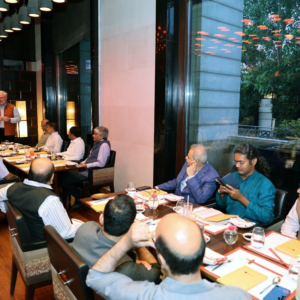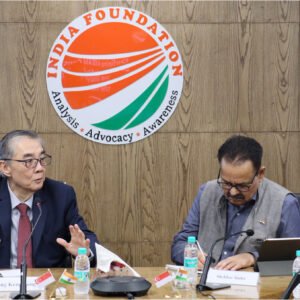The debate on these pages on February 13 was, as I see it, a good attempt to widen an ongoing online debate. The issues raised by Harsh Gupta and Rajeev Mantri (‘One versus group’, IE) are critical for two reasons. Through 65 years of our independence, we saw citizenship rights being increasingly coloured and muddled by identity politics. Newer interpretations of constitutional principles and goals are being offered. Periodically, actions enforced either through the executive or the legislature hit at the basic structure of the Constitution “we, the people” have given ourselves. Second, during this period, and even today to an extent, public discourse is stifled by a section of the intelligentsia who set its framework and terminology. Others questioning either the terminology or the substance are rejected and ridiculed. This suited the establishment that had adopted the socialist model of delivering democracy to the people. Now, with socialism itself tempered down, the inaccuracy of their jargon stands out. It is time to conduct debates with greater openness both on issues and on terminology.
In his response (‘Why India must allow hyphens’, IE, February 13), Ashutosh Varshney has chosen to remain in the good old world with all its definitions. He has missed an opportunity to look afresh at the aspirational generation that hopes to contribute to a strong and emerging India. Much like in Varshney’s hyphenated United States, hyphenated communities in India are looking for opportunities to learn, perform and better themselves. The Tamil-Indian or the Muslim-Indian from Uttar Pradesh or Bihar is looking for English medium schools, skills to make themselves employable and to live with their families in a safe and secure environment. However, Varshney’s impression that America allows minorities to flourish on the grounds that Diwali is celebrated in the White House is simplistic. A few years ago, the struggle and campaign carried out by American-Hindus to have errors about their religion removed from school curriculum was well publicised. Varshney may have missed this.
That a large section of blacks and hispanics are yet not part of the voter list is also news that perhaps did not reach Varshney. Americans will allow minorities to flourish, indeed, if they allow the Hindu undivided family for all purposes of definition or even personal laws on civil issues, as we do for our minorities in India.
Varshney has reduced this entire debate to discuss Modi. He portrays the Modi of 2002 as a fascist. Gujarat pre-Modi, Indira Gandhi’s Nellie, Meerut, Moradabad and Bhagalpur, and anti-Sikh riots in Delhi, do not exist for him, even for the sake of reference. If, by clever wordplay, it is Modi’s support base that is being compared to European fascists, how would Varshney describe the support bases of Labour in the UK in 1945, the swing to the right during Ronald Reagan’s tenure as US president, Indira Gandhi in 1972 or even that of Barack Obama ?
In the just-concluded elections in Gujarat, Muslims came out to vote in large numbers. Twenty-five constituencies having over 20 per cent Muslim voters witnessed 70.8 per cent voting on average, in line with the state average. The BJP won the two most Muslim-dominated constituencies of the state (having around 60 per cent Muslim population) — Surat East by around 16,000 votes and Jamalpur-Khadia by 6,000 votes. Jam Salaya Nagarpalika, which has 90 per cent Muslim voters, is a BJP-ruled body. Other than those online, these too form Modi’s support base. Would Varshney call them fascist too?
Varshney sounds confused when he says, “Hindu nationalists have always sought the former [nationhood built on uniformity]; Gandhi and Nehru whose ideas won out and were finally enshrined in the Constitution, thought accommodation of diversities would make minorities secure”. The directive principles in the Constitution describe the destination that the republic should reach, and that includes a uniform civil code for all citizens. It includes stopping cow slaughter and so on. Constitution-makers hoped that every step taken by the executive or legislature would lead towards this ideal state. How long this should take is obviously unsaid. Hence, by inference, the position as of 1947 or 2013 is interim, or being on the way to that ideal state as envisaged in the directive principles. So when Varshney states, “In India, undifferentiated citizenship is an ideologue’s or a philosopher’s pipe dream with ghastly real-world implications”, he is not in sync with the Constitution itself. “Haven’t we learned from the violent tragedies of Europe in the first half of the 20th century,” he asks? The Constitution was drafted well after those tragedies, Professor. Do you underestimate the great men and women who sat in the Constituent Assembly?
“The accommodation of diversities” that the Constitution allows for by implication is to allow a community to be ready for the changes in law that should govern them on the road to the ideal state. Speaking in May 1955 on the Hindu code bills, Acharya J.B. Kripalani said, “If we are a democratic state, we must make laws for not one community alone. Today, the Hindu community is not as much prepared for divorce as the Muslim community is for monogamy… I charge you with communalism because you are bringing forward a law about monogamy only for the Hindu community. You must bring it also for the Muslim community. Take it from me that the Muslim community is prepared to have it but you are not brave enough to do it.” Surely, Kripalani was no Hindu nationalist. And later, when the Congress reversed a Supreme Court judgment, otherwise a step forward for women in this journey towards the ideal state, they were again not being brave enough. They “assist in slowing this natural evolution to a composite, dynamic melting pot.” Importantly, to bring to Varshney’s notice, Modi was nowhere in the scene.
Varshney continues, “Modi has by now become the poster boy of the markets, though Manmohan Singh gave birth to the new economic era… Liberals like me find markets necessary, but not sufficient… the government’s welfare, regulatory and public-goods function remain.” Manmohan Singh may have launched the new economic era in 1991, but from 2004 till date under his leadership, nothing can explain the economic muddle we are in. In contrast, whether it is agriculture, industry, infrastructure or energy, Modi’s performance is there for all to see. For liberals like Varshney, Modi has ensured that Gujarat ranked first in implementing the 20 Point Poverty Alleviation programme. Gujarat has consistently received “good” status under the PM’s 15 Point Programme for minorities. The Sagarkhedu Yojana for the comprehensive development of the coastal belt has a major share of Muslim fishermen as beneficiaries. Rs 11,000 crore was spent on this over the last five years and a new package of Rs 21,000 crore has been declared this year. The Bakshi Panch community welfare programmes cover as many as 50 Muslim communities. Districts Bharuch and Kutch (with approximately 21 per cent Muslim populations each) are among the fastest developing districts in India.
Varshney is incorrect when he refers to Vivekananda. The swami certainly wanted a Hindu mind in a Muslim body, and hence the reference to biceps and the Bhagavad Gita. However, his reference to beef as quoted by Varshney is nowhere to be found. Nehru and Gandhi did not disregard him. Varshney’s pitting of Vivekananda’s masculinity against Gandhi and Nehru’s feminine and soft India is unacceptable as their contexts are different. Even so, Shakti is a vigorous and not at all soft form of female power. The eminent professor has squandered the opportunity for a dispassionate debate.
(The article was originally published in The Indian Express on February 20, 2013. http://www.indianexpress.com/news/the-tyranny-of-hyphens/1076577/0)



